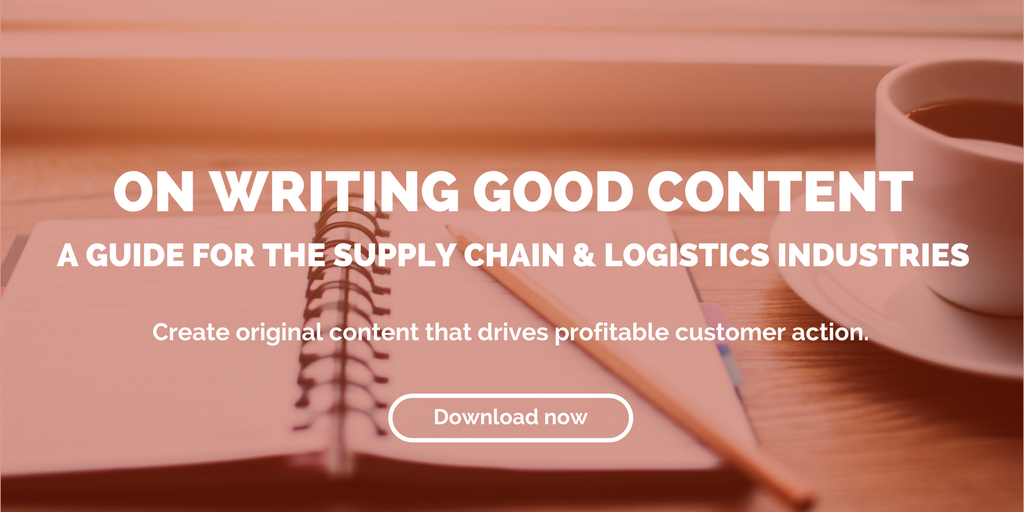
by Fronetics | Aug 23, 2016 | Blog, Content Marketing, Logistics, Marketing, Social Media, Strategy, Supply Chain

TotalTrax leverages content marketing to increase web traffic, generate high-quality leads, and, ultimately, grow business.
TotalTrax, Inc., is a provider of real-time vehicle, driver, and inventory tracking technologies for manufacturing and warehouse operations. Despite a decade of positive growth, the company knew it was missing opportunities for new business because of its lack of a clear digital strategy.
That’s why TotalTrax hired Fronetics Strategic Advisors. The firm created and implemented a multi-channel content marketing program designed to increase the company’s digital footprint and accelerate growth.
Content marketing can help a business elevate its brand position by producing content that demonstrates industry expertise, offers valuable information, and builds trust with their target audience. Example benefits include:
- Increased brand awareness
- Higher referral traffic
- Better lead generation and nurturing
- Improved customer loyalty and trust
- Decreased marketing cost and higher ROI
Fronetics evaluated TotalTrax’s existing digital assets. Leveraging extensive market research, the firm helped refine the company’s messaging and content distribution to better engage potential customers. Fronetics then implemented the customized content marketing strategy to help TotalTrax fully leverage its web presence to bring about new business.
The results
In a 24-month period, TotalTrax realized significant gains in web traffic, quality leads, and brand awareness. Key results included:
- 19% increase in overall web traffic
- 500% increase in traffic from social media
- 244 high-quality leads
- 30% net increase in new customers
To learn more about Fronetics’ strategy for TotalTrax, download the free case study below.

Related posts:

by Fronetics | Aug 8, 2016 | Blog, Content Marketing, Marketing, Strategy

B2B marketers who meet more often to discuss and evaluate their content marketing strategy report success at much higher rates than those that meet less frequently.
Do you feel your content marketing is producing results? Only 30% of B2B marketers say they feel effective, and a shocking 55% admit they do not actually know what content marketing success looks like.
If this sounds familiar, take a note from the most effective B2B marketers: Meeting more often can improve content marketing performance.
Another meeting? Say yes for success
We all have been guilty of thinking, “Great. Another meeting to squeeze into my schedule.” But the B2B Content Marketing 2016: Benchmarks, Budgets, and Trends – North America found some interesting correlations between content marketing effectiveness and frequency of meeting. For instance:
Meeting daily or even weekly improves content marketing results.
61% of the most effective B2B marketers meet daily or weekly with their content marketing team, either virtually or in person.
Meeting more often is time well spent.
Teams that meet daily or weekly find the meetings to be more valuable (70% of respondents) than those who meet less often — like biweekly or monthly (49%). But, only 36% of the content marketing professionals surveyed met once per week, and only 8% met daily. And you guessed it: Those were the teams that reported having the most success with their content marketing.
Meeting strategies
There is more to success than simply holding a meeting, of course. Time spent around the conference table is not going to bring results unless you are asking the right questions with keeping eyes on your content strategy.
What are the new challenges the team is facing? What is happening in the news or industry that might affect or interest your audience? How is your audience responding to recent content? There must be more to regular meetings than coffee and bagels.
Equally important is ensuring the team has a clear vision of your goals and benchmarks. The greater the team’s understanding of what success looks like — clearly defined objectives, expectations, and your content marketing goals — the more effective they can be at their job.
Things to discuss about your content strategy:
- Purpose: What is the goal or objective the team is striving for from content marketing efforts? More leads and increased brand recognition are common examples.
- Audience: Who is your target audience, and what are their needs, interests, and concerns? Where do they consume content (e.g., LinkedIn, blogs)? When do they visit those channels?
- Tactics: What platforms are you using for distribution, and how do they work together? Is there an email campaign as well as daily Facebook, Twitter and Instagram posts, for example? Are images important for results?
General discussions to include:
- Open-topic communication: Tap into knowledge from all members of the team to generate ideas, information, and data for content creation. Open discussion can bring insight and fresh angles of approach.
- Ways to improve and reach objectives: Fresh ideas are as important to the team as fresh content. What could you be doing better? Should you be measuring something that you’re not? Are there new technologies or tools that you should try? Every team member should have a voice in how to best execute or improve your content strategy.
Related posts:

by Fronetics | Aug 3, 2016 | Blog, Content Marketing, Marketing

Here are some guidelines on what content marketing might cost your business and why you need each element to be successful.
Content marketing can be a game-changing strategy for companies looking to increase brand awareness, improve lead-generation efforts, and grow their business. But sticker shock can prevent some from pulling the trigger — especially when an organization is unsure how to measure ROI.
Content marketing will require an investment in services that are not cheap (writing, design, social media management, etc.) or a major time commitment from your own human resources. That being said, the more dollars or resources you throw at it will not necessarily ensure greater success.
To find the right pricing for your content marketing, it’s important to understand what you are paying for. Here are some guidelines for how much content marketing should cost (if you’re doing it right).
A pricing breakdown
The right content, published at the right time, reaches buyers who are looking for products or services like yours and informs them about your business. That, in turn, entices them to become customers.
Here’s the rub: You cannot just throw any old content out there and expect it to work. Here is what you need:
1) A data-driven inbound marketing strategy
This initially may cost around $20k. That sounds like a lot, but here’s why it is so important.
Research proves that content marketing is drastically more effective when it is 1) backed by a strategy, 2) the strategy is documented, and 3) a designated person is leading the strategy. Whether created by an in-house team or an outsource partner, your strategy should be driven by data, and should include these vital components:
- Buyer personas and journey: Who your potential customer is and what steps they take to research, evaluate, and decide to buy
- Content mapping and demand generation: What topics appeal to your customers? How and when should you deliver content? What channels reach customers best?
- Conversion and scoring leads: How to optimize lead-conversion rates and evaluate leads throughout the buyer journey; identifying optimal timing for sales calls
- Goals and KPIs: Define what success looks like and how to measure progress
2) Content marketing talent
Human resources may cost $5K-$10K per month. You need a team of skilled writers, graphic designers, and social media managers who can produce quality content, on a regular basis, and distribute it effectively.
Why can’t you just have the intern do it and save some cash, you ask? When it comes to content, you get what you pay for. Consider that 27 million pieces of content are shared every day. That means consumers can afford to be picky about the media they consume. If they find your content lacking in quality, substance, or appearance, they simply won’t read it. You might as well not have written it.
For your content to be effective — meaning your content attracts your target audience and drives profitable customer action — it must stand out, really stand out, among the masses. For that, you need a professional hand.
3) Lead management, marketing software and analytics
This may cost about $10k per month. It includes marketing automation software, like HubSpot, as well as a skilled manager(s) to provide insight and reports on content performance. This way your organization can effectively track leads, evaluate what is working, and adjust your strategy as necessary to ensure optimal performance.
Return on investment
If you’re still uncomfortable with these numbers, keep these in mind: Content marketing costs 62% less than traditional marketing and generates about 3 times as many leads.
Content marketing is valuable in growing any business. But remember that getting your return really does require making that investment.
Related posts:


by Fronetics | Jun 16, 2016 | Blog, Content Marketing, Manufacturing & Distribution, Marketing, Strategy, Supply Chain

A recent report produced by the Content Marketing Institute and MarketingProfs, and sponsored by Brightcove, found that 81% percent of B2B manufacturers in the United States use content marketing. The same report found that the majority of manufacturers do not believe their organization is effective at content marketing.
What are organizations who are not effective missing out on? A lot.
An effective content marketing strategy can:
- Build brand awareness
- Position your company as a thought leader within the industry
- Increase engagement with customers, partners, and stakeholders
- Educate and inform customers, partners, and stakeholders
- Build trust
- Allow you to manage your reputation
- Generate leads
How can your organization realize these benefits?
The first step is documenting your strategy. The report found that organizations with a documented strategy in place were 3x more likely to report that their content marketing strategy was effective than organizations without a documented strategy.
Define your goals
Why does your company want to create content? Do you want to shorten your sales cycle? Increase leads? Build brand awareness? You don’t want your content to be just stuff. You don’t want content to be ineffective. Therefore it is important to define what it is you want your content to do for your company.
Define your audience
Who is your target audience? What are their needs? What are their goals? What are their pain points? What do they value most? Where do they go for information? Take your time. Be honest. If you identify and define your audience correctly you will be more likely to reach your target audience and engage them than if you get this step wrong.
Define your metrics
Determine how you are going to track and measure success. Define the metrics that you will track on a daily, weekly, monthly, and yearly basis.
Identify the right distribution channels
When it comes to content, distribution is essential – your content will not reach your target audience and will not be read unless it is distributed. Take the time to identify the distribution channels that are right fit for your company, your content, and your goals.
Create a publishing calendar
A publishing or editorial calendar provides you with a framework to create and distribute content. It helps you create content that is consistent, that is quality, and is tailored to your company’s goals. It is also helpful in terms of managing workflows, meeting deadlines, and managing writer’s block.
Create content
Valuable and relevant content is not a sales pitch. It is not content that pushes your products and services. Rather, it is content that communicates valuable information to customers and prospects so that they have the knowledge to make better informed decisions. Moreover, it is content that establishes your business as a reliable source of knowledge – as the thought-leader within the industry. Be thoughtful when you create content.
Curate content
Content will help you grow your business; by creating and distributing valuable and relevant content in a strategic and consistent manner you can drive profitable customer action. But, it’s not all about you. It’s not all about the content you and/or your business creates. Here’s why content curation is an essential component of a successful content strategy. The internet is a fire hose stream of content. Being able to navigate the deluge of content and identify the content that is valuable to your customers and to your business is essential. The process of identifying and sharing this content is content curation. By consistently being able to identify, make sense of, and share content that is important and relevant to your customers and to your industry you will establish your business as a thought leader and a trusted resource.
Distribute content
Distribute your content via your target distribution channels. Distribute the content consistently over time and at the right time.
Engage with customers and prospects
Once your content has been distributed, engage with your audience. Respond to comments, respond to questions, and provide clarification. Make your content more than words – make it a relationship.
Track and analyze metrics
Track and analyze your metrics on a daily, weekly, monthly, and annual basis. Take a look at what is working and what is not. By tracking and analyzing your metrics you can see, for example, what type of content is most effective and which distribution channels are helping you achieve your goals.
Make adjustments as needed
Your strategy should not be set in stone. Your strategy should be flexible. Look at your metrics, look at the feedback you are getting through your engagement with customers and prospects – make adjustments to your strategy as needed. Remember that when it comes to content it is important to think marathon not sprint. An effective content strategy requires patience and determination. Many companies make the mistake of giving up on a content strategy too early; make a long-term commitment to your strategy.
This post originally appeared on Electronics Purchasing Strategies.
You may also like:


by Fronetics | Jun 9, 2016 | Blog, Content Marketing, Marketing, Strategy

A data-driven content marketing strategy will increase your program’s success and help win the buy-in of executives.
What is driving your digital and content marketing strategy? If all you have in the driver’s seat are a few creative ideas, you may find yourself frustrated with the results and struggling to garner support from the C-Suite.
Different audiences respond in different ways. The question is, where are your potential new customers and what are they looking for? Data plays a critical role in uncovering those answers.
Data can guide you to:
- Define your target audience. Who are you trying to reach? When can you best reach them?
- Select the best topics for your content. What information do they need, and what will peak their interest? What do they seek most from the content they read?
- Narrow down a distribution strategy that will produce results. Which digital and social media channels will best reach your audience, grow your business, increase sales, and improve your brand’s reach? Which networks are your competitors using most?
- Gauge what is working and what is not. Reportedly, 53% of digital content marketers don’t measure their success. No wonder so many content marketing programs fail. If you don’t take the time to determine what content is resonating with your target audience, how will you know what to produce in the future?
- Tune into market changes. As your business evolves and customers’ needs change, data serves as your compass to remain competitive in an ever-changing marketplace.
A data-driven strategy will win over the C-suite
In addition to giving you a foundation for your strategy, data can garner the support of the C-suite, which you must have in order to fund your marketing program. A plan based simply on ideas, no matter how brilliant, will not appeal to executives who base decisions on data.
They want to see how your marketing plan provides answers to the needs of your target audience (potential customers) and what those customers are worth to the company’s growth and success. If your strategy aligns with data, they’ll be able to get behind every point.
Creating a data-driven strategy
Aligning your strategy with data takes some time and effort, but it is crucial to optimizing the performance of your content marketing program and winning C-suite support. Here are some steps to get started.
- Analyze your reports, data, and interviews with stakeholders in the company about your target customer. Compile this information, and document the very specific demographic(s) you want to reach. Research the digital behaviors and patterns of this demographic.
- Audit your existing content (or hire an expert to do it). Look at the substance, source, and performance of your most successful and your least successful assets. Are there changes you can make to your poor-performing content to improve it, based on learnings from your successful content and your audience research?
- Plan an editorial calendar of future content based on what has been successful in the past. Sharing this information and seeking ideas from employees outside the marketing department can be a very valuable exercise.
- Test the distribution channels and times that have been most successful in the past and that fit the behaviors of your target audience. Continually refine your distribution strategy based on your results.
- Don’t forget to document your strategy! Marketers who put it in writing report success at significantly higher rates than those who don’t document their strategies.
By distributing the right content, at the right time, to the right audience, on the right channels, your content marketing program will reach its maximum potential.
Related resources:











